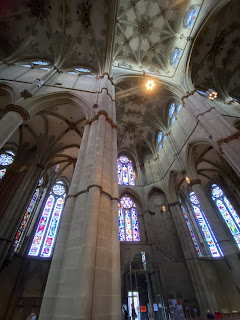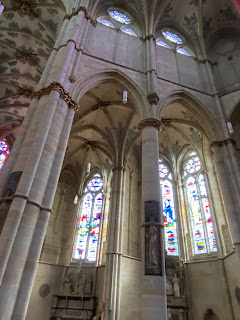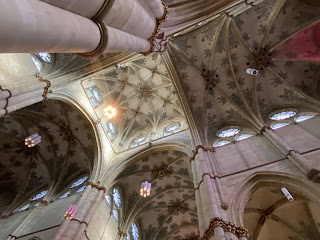So, da bin ich wieder, vor dem Dom und auch vor der Liebfrauenkirche. Wenn man beide von außen betrachtet, meint man, es nur mit einer Kirche zu tun zu haben und ich war etwas irritiert, dass sich zwei Kirchen beinahe eine Hauswand teilen. Ich komme aus Berlin, da springen einen Kirchen selbst innerhalb von Häuserzeilen an, aber Trier setzt noch mal einen drauf. Trier ist die Stadt der Doppelkirchen. War die Simeonkirche an der Porta Nigra doppelstöckig, war die antike Kirche, die Kaiser Konstantin anlegen ließ eine nebeneinander-Doppelkirche. Wie im letzten Post (https://fraumb-far-far-away.blogspot.com/2021/10/trier-2021-der-dom-von-trier-cathedral.html?m=0) bereits erzählt, hat diese Anlage durchaus gelitten, unter nicht so überzeugten Kirchgängen wie den Franken und den Wikingern und natürlich unter der Zeit. Nach 1000 Jahren war ein Neubau nötig.
Eine neue Zeit, ein neuer Stil, neue Ideen, diesmal kamen die Architekten nicht aus Rom, sondern aus der Champagne und von der Île de France und sie erschufen ein gotisches Juwel. Baubeginn war ca 1230 und nach dem die halbe Kirche fertig war, war das ganze Geld alle. Aber hier fand sich eine Lösung, Ablasshandel sei Dank und 1260 war der Bau vollendet.
Auch hier gab es im Laufe der Zeit Veränderungen, einmal wurde eine kunstvolle Turmspitze von einem Sturm zerstört, es gab Änderungen in der Ausstattung und zwischenzeitlich wurde die Kirche als Grabkirche für das Domkapitel genutzt und nach und nach muss es wie in einem Bestattungsinstitut ausgesehen haben. Dann erschien Napoleon, er kam, er sah und hatte seine eigene Meinung. Eigentlich wollte er auch diese Kirche abbauen lassen, aber der Trierer Bürgermeister verwies daraus, dass es sich doch um ein Meisterwerk französische Architektur handele. Napoleon ließ von der Kirche ab und da steht sie heute noch. Im 2. Weltkrieg schwer beschädigt, wurde sie von 1946 bis 1951 wieder erbaut, also, neues Dach, die Wände ausbessern, neue Fenster, neue Einrichtung, der Fußboden war ganz gut erhalten.
Nun wollen wir einen Blick hinein werfen, das Tympanum zeigt wie bei vielen gotischen Kirchen Maria mit dem Kind im Zentrum, die Heiligen drei Könige auf der einen Seite, Jesus im Tempel auf der anderen. Die Statuen am Portal zeigen sowohl Figuren aus der Mythologie als auch Kirchenmänner. Mein erster Gedanke war, oh, ein nackter Mann am Eingang einer Frauenkirche, schön! War aber nur der Adam, Eva steht ihm gegenüber, das Traumpaar getrennt. Probleme habe ich mit der Darstellung der Synagoge als Verlierer im Wettstreit der Religionen.
Die Tür an sich ist schlicht und dann stehe ich im Innenraum und denke: Wow! Während der Dom streng und maskulin erschien, ist die Liebfrauenkirche genau das - lieblich und fraulich. Das ist die am meisten feminine Kirche, die ich je gesehen habe. Der Raum erscheint fast rund, der Grundriss soll eine zwölfblättrige Rose darstellen und alles erscheint sanft und weich. Die Glasfenster lassen den Raum in roten, violetten, blauen und orangenen Farbtönen erstrahlen und überall sieht man Mütter und Babys.
Die Kirche wirkt wie aus Stein geklöppelt und wie aus einem Guss. Sie erinnert mich an Saint Chapelle in Paris ohne deren Ernsthaftigkeit (https://fraumb-far-far-away.blogspot.com/2015/01/paris-saint-chapelle.html?m=1), diese Kirche ist ein Ort, an dem María einfach nur die Mutter eines kleinen Kindes ist, alles Ungemach, aller Kummer, alles Leid sind noch fern. Nur im schmalen Raum, der zum Dom führt, gibt es eine Pieta.
In der Kirche gibt es auch ein kleines Schaufenster in die Vergangenheit, man kann die einzelnen Phasen der Bebauung anhand von Ausgrabungen erkennen.
Sehr gefallen hat mir der Altar in der Mitte mit der Taube die nach unten schaut, als wolle sie in einem Buch lesen, das auf dem Altar liegt.
English version below
I’m back again, in front of the cathedral and the Liebfrauenkirche ( the official translation is Church of our Lady). When you first look at them, you got the impression it’s just one church and I was a bit confused by the idea that two churches are sharing one exterior wall. I’m from Berlin, we even have churches imbedded in house lines, but Trier definitely tops that. Trier is the city of double-churches. Was the Simeonchurch at Porta Nigra a two storey church, is this ancient church ensemble built by emperor Konstantin a side-by-side double church. Like I told in my last post (https://fraumb-far-far-away.blogspot.com/2021/10/trier-2021-der-dom-von-trier-cathedral.html?m=0 ) the facility was indeed suffering from not really convinced churchgoers like the Franconians and the Vikings and of course from time. After 1000 years a new building was necessary.
A new time, a new style, new ideas, this time the architects didn’t came from Rome but from the Champagne and Île de France and they created a gothic jewel. The construction started around 1230 and after they were halfway done, the money was completely gone. But a solution was found and thanks to sales of indulgence the work could go on and 1260 the church was finished.
Here too some alterations took place, one time a beautiful canopy was blow away in a storm, some changes in the interior were done and for a while the church was used as sepulchral church for the cathedral chapter. Step by step it looked like an undertaker’s institute. Then Napoleon arrived, he came, he saw and he got different opinions. He wanted the church being torn down, but the Mayor of Trier did remind hin, that they are talking about French architecture. Eventuell he let go and so the church is still here. Badly wounded in WWII it was rebuilt from 1946 to 1951, new roof, renewing the walls, new windows and ornaments, the floor was fine.
Now let’s go and have a look inside. The tympanum shows like many gothic churches Maria with the child in the centre, left hand side the Holy Three Kings and on the other side Jesus at the temple. The statues at the portal showing figures out of the mythology and persons from the diocese. My first thought was, oh, a naked man at the entry of a women’s church, how nice. But it turned out, it’s only Adam, Eva is standing opposite, the perfect couple separated, and I had a personal problem with the display of Synagoga as a looser in the religious competition.
The entry door is quite plain and then I’m inside and I’m like: Wow! While the cathedral is severe and masculine, is the Liebfrauenkirche (Lovely-Woman’s-Church) exactly that - lovely and womanly. That’s the most feminine church I ever saw. Der room appears nearly round, the ground plan looks like a twelf-petal rose and everything seems soft and tender. The stained glass windows do bath the room in red, purple, blue and orange light and everywhere you see mothers with babies.
The church is like laced of stone and as if made from one piece. It reminds me of Saint Chapelle in Paris, but without its sobriety (https://fraumb-far-far-away.blogspot.com/2015/01/paris-saint-chapelle.html?m=1), this church is a place where Maria is just the mother of a young infant, all the hardship, the grief, the pain is far away. Only in the small hallway that leads to the cathedral you find a Pieta.
In the church floor you find a small window into the past and one can see different phases of construction during the centuries.
I liked much the altar in the centre of the church with the holy dove looking from above like reading a book on display.
































Keine Kommentare:
Kommentar veröffentlichen